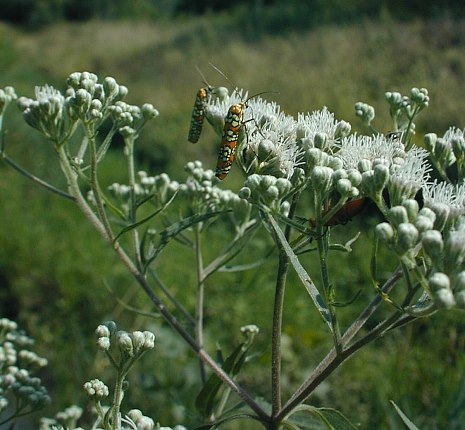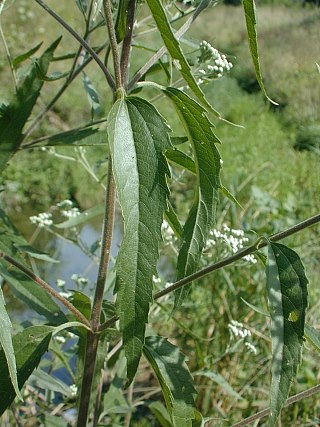Description: This herbaceous perennial plant is 3-6' tall. It is largely unbranched below, but forms occasional side stems toward the apex. The stems have indistinct lines of white hairs, and are generally pubescent. The leaves are primarily opposite, although the upper leaves near the inflorescence sometimes alternate. These leaves are up to 7" long and 2½" across, with petioles up to 1" long. They are lanceolate, largely hairless, with coarse serration along the margins, and there are 5 veins that diverge from the base. These leaves tend to nod downward from their petioles, and are often dark green.

The flat-topped
inflorescence consists of numerous heads of white disk florets; there
are no ray florets. Each flowerhead has about 12 disk florets. Each
disk floret is about ¼" long, narrow and tubular, with 5 small
triangular lobes at the top. There is also a long divided style that is
white, which protrudes conspicuously from each floret. The blooming
period occurs during late summer or early fall and lasts about a month.
There is occasionally a mild floral scent. The small achenes develop
flat tufts of hair and are dispersed by the wind. The root system is
fibrous and rhizomatous. This plant often forms colonies by means of
these rhizomes.
Cultivation:
The preference is partial or full sun and moist conditions. The soil
should be loamy and high in organic matter. Lower leaves sometimes
discolor and fall off during a drought, otherwise this plant is subject
to few problems. The size of this plant is significantly affected by
moisture levels.

Range & Habitat:
The native Late Boneset occurs in nearly all counties of Illinois,
except for
possibly three counties in the north (see Distribution
Map). This is a common plant. Habitats include moist black
soil prairies, moist meadows near rivers, swamps, areas near drainage
ditches, low-lying areas along railroads and roadsides, pastures, and
abandoned fields. This plant is often near sources of water, or where
the water table is not far below the land surface. It is more common in
disturbed areas.
Faunal Associations:
The flowers are very popular with many kinds of insects, including
long-tongued bees, short-tongued bees, wasps, flies, small to
medium-sized butterflies, skippers, moths, and beetles. Most of these
insects seek nectar, although bees may collect pollen and beetles may
feed on it. In the upper photograph, are two Ailanthus Webworm Moths
sucking nectar from the flowers. The caterpillars of various moths can
be found feeding on various parts of this and other Bonesets, including
Haploa clymene (Clymene Moth; eats foliage), Phragmatobia
lineata (Lined Ruby Tiger Moth; eats foliage), Carmenta
bassiformis (Eupatorium Borer Moth; bores into roots), Schinia
trifascia (Three-Lined Flower Moth; eats flowers and seed
capsules). Mammalian herbivores rarely consume this plant because of
the bitter foliage. In overgrazed pastures, Late Boneset often becomes
more common because of reduced competition from other plants.
Photographic Location:
The photographs were taken along a drainage ditch in Judge Webber Park
in Urbana, Illinois.
Comments:
The delicate flowers of Late Boneset closely resemble the flowers of
other Bonesets, such as Eupatorium altissimum (Tall
Boneset) and Eupatorium perfoliatum (Common
Boneset), in both color and structure. These Bonesets can be
distinguished readily from each other by an examination and comparison
of their leaves. Tall Boneset has leaves that are pubescent, more
narrow, and less coarsely serrated than Late Boneset, while Common
Boneset has leaves that wrap around the stem and are without petioles.